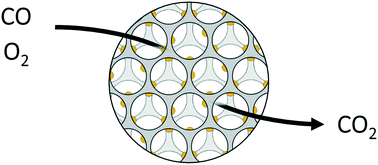The dynamic behavior of dilute metallic alloy PdxAu1−x/SiO2 raspberry colloid templated catalysts under CO oxidation†
Abstract
Dilute palladium-in-gold alloys have potential as efficient oxidation catalysts; controlling the Pd surface distribution is critical. Here, the activity for CO oxidation catalyzed by robust dilute Pd-in-Au nanoparticles supported on raspberry-colloid-templated (RCT) silica depends on the pretreatment and gas environment. The activities of oxygen-pretreated catalysts are different in light-off studies versus after long-term use. Transient increases in activity are also induced by flowing CO/He at 553 K. Altogether, these results indicate changes in Pd distribution at the surface induced by reactive gases and that light-off studies alone are not adequate for evaluation of alloy catalyst performance. Kinetic studies show evidence of both isolated and multiple Pd atoms. A dual-site mechanism is operative over Pd0.02Au0.98 RCT-SiO2, whereas a single-site mechanism governs reaction over Pd0.10Au0.90 RCT-SiO2. The distinct mechanisms suggest that tuning the ratio of isolated to clustered Pd sites is possible, underscoring the importance of characterization under reaction conditions.



 Please wait while we load your content...
Please wait while we load your content...
